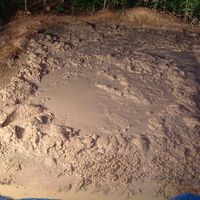
Oct 15, 2013
Hey guys – we got your weekend plans all figured out: Build your own quicksand pit!
What gives quicksand its wriggle-worthy properties? Its non-Newtonian nature, of course (you didn’t see that coming). The properties associated with being one of those wacky fluids is their ability to change viscosity based on the rate and force of applied stress. Quicksand is the echt example but ketchup, gak, and bogs are all non-Newtonian. Thankfully, you don’t have to be Newton to build your own pit. You just need to know Fred.
We found Fred through Dan Engber, the journalist who got us all thinking about the goopy stuff for our Quicksaaaand! podcast. Dan ran into Fred while researching the quicksand fetish community; Fred is the managing director of a studio where films featuring quicksand are made (he prefers we don't use his last name). As part of his job, Fred is the guy who re-creates different types of quicksand pits. He told us that depending upon the size, shape, and distribution of particles you use, there are two types "quicksand" you can create, based on the two ways non-Newtonian fluids behave.
Traditional sand-based quicksand is thixotropic. So when undisturbed, it is solid-like, but when suddenly shaken or agitated, it becomes less viscous and more fluid. In laymen’s terms, if you come across one of these pits when you’re furiously running down a jungle trail (away from Sasquatch, obvi), the moment you hit the pit’s surface you disrupt the sand's placid state, making it more liquid-y, less solid-y, and thus able to suck you in.
“Traditional quicksand is sand in a constricted area, with water percolating up through it," says Fred. "What happens is the sand particles are lifted by the pressure underneath, making a cap on top that looks like walkable ground.”
When someone steps on the surface, their body weight displaces the deeper water, causing it to rise to the surface.
Another funky behavior of non-Newtonian fluids can be seen in game shows, where contestants run across pools of cornstarch and water. No, they aren't walking on water, rather, they are banking on the other way non-Newtonian fluids can behave. Known as dilatancy, this property is defined by a fluid's ability to harden under stress. Sadly, or perhaps fortunately, dilatancy pits are only found on game shows, not out in nature (but if you do find yourself on a game show, and you want to get in, then you need to inch in slowly).
Natural quicksand pits come in many different flavors, from sand to clay or peat. Keep in mind, says Fred, “Sand is the most dangerous."
"You may only be knee-deep, but once the sand locks up, you become trapped and exposed to the elements," he explains.
Want to make your own pits? Here are some recipes to sink by.



Some safety notes:
*If you get sucked into sandy quicksand, once you stop moving, the sand will return to a more solid state, and trap you. So it turns out, the more you wriggle and squirm, the looser the sand will become, allowing space for your body and allowing you to get out. In quicksand prone areas, like Alaska, fire fighters sometimes use a wand (for our purposes, any hose will work) to shoot water or air underneath the trapped body, loosening the sand particles and voila! Freedom!
*Clay is quite slippery when wet, so be sure to have a dry rope nearby to pull your body out.
*To sanitize any of your pits (expect the peat one to grow its own ecosystem of bugs and bees, says Fred), you can occasionally shock them with chlorine.
*Remember folks, don’t make the pit any deeper than you are tall; Fred keeps his around five feet.
** OBLIGATORY WARNING!
Hey kids, if you do successfully build a quicksand pit, don't be evil and lure unsuspecting people and animals into it. And don't get yourself stuck with no hope of rescue.